Human food
Human food is food which is fit for human consumption, and which humans willingly eat. Food is a basic necessity of life, and humans typically seek food out as an instinctual response to hunger; however, not all things that are edible constitute as human food.
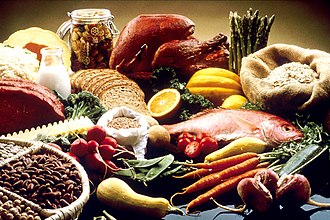
Humans eat various substances for energy, enjoyment and
Today, the majority of the
The food system has significant impacts on a wide range of other social and political issues, including:
Food sources
Humans are omnivores finding sustenance in vegetables, fruits, cooked meat, milk, eggs, mushrooms and seaweed.

Humans eat thousands of plant species; there may be as many as 75,000 edible species of
Fish and other marine animals are harvested from lakes, rivers, wetlands, inland waters, coasts, estuaries, mangroves, near-shore areas, and marine and ocean waters. Although aquatic foods contribute significantly to the health of billions of people around the world, they tend to be undervalued nutritionally, primarily because their diversity is framed in a monolithic way as "seafood or fish." Worldwide, aquatic foods are available every season and are produced in a wide variety. Over 2,370 species are harvested from wild fisheries, and about 624 are farmed in aquaculture. Fish powder for infants, fish wafers for snacks, and fish chutneys have all been developed because marine foods are nutrient-dense.[17]
Taste perception
Some animals, specifically humans, have five different types of tastes:
Sweet

Generally regarded as the most pleasant taste,
Complex carbohydrates are long chains and do not have a sweet taste.In the natural settings that human primate ancestors evolved in, sweetness intensity should indicate energy density, while bitterness tends to indicate toxicity.[21][22][23] The high sweetness detection threshold and low bitterness detection threshold would have predisposed our primate ancestors to seek out sweet-tasting (and energy-dense) foods and avoid bitter-tasting foods.[24]
Artificial sweeteners such as sucralose are used to mimic the sugar molecule, creating the sensation of sweetness, without the energy. The stevia plant contains a compound known as steviol which, when extracted, has 300 times the sweetness of sugar while having minimal impact on blood sugar.[25]
Sour
Salty

Other than enhancing flavour, salty foods are significant for body needs and maintaining a delicate electrolyte balance, which is the kidney's function. Salt may be iodized, meaning iodine has been added to it. Iodine is a necessary nutrient for maintenance of thyroid function, and the addition of iodine to salt became a public-health practice in the mid 20th century to prevent iodine deficiency and relate diseases such as endemic goitre.[27][28]
Some canned foods, notably soups or packaged broths, tend to be high in salt as a means of preserving the food longer. Historically salt has long been used as a meat preservative as salt promotes water excretion. Similarly, dried foods also promote food safety.
Bitter
Umami
Umami has been described as savoury and is characteristic of broths and cooked meats.[29][30][31][32]: 35–36 Foods that have a strong umami flavor include meats, shellfish, fish (including fish sauce and preserved fish such as Maldives fish, sardines, and anchovies), tomatoes, mushrooms, hydrolyzed vegetable protein, meat extract, yeast extract, cheeses, and soy sauce.
Cuisine
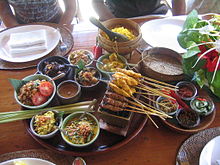
Many scholars claim that the rhetorical function of food is to represent the culture of a country and that it can be used as a form of communication. According to Goode, Curtis and Theophano, food "is the last aspect of an ethnic culture to be lost".[33]
Many cultures have a recognizable cuisine, a specific set of cooking traditions using various spices or a combination of flavours unique to that culture, which evolves. Other differences include preferences (hot or cold, spicy, etc.) and practices, the study of which is known as gastronomy. Many cultures have diversified their foods by utilizing preparation, cooking methods, and manufacturing. This also includes a complex food trade which helps the cultures to economically survive by way of food, not just by consumption.
Some popular types of
Presentation

Aesthetically pleasing and eye-appealing food presentations can encourage people to consume food. A common saying is that people "eat with their eyes". Food presented in a clean and appetizing way will encourage a good flavour, even if unsatisfactory.[34][35]
Another universal phenomenon regarding food is the appeal of contrast in taste and presentation. For example, such opposite flavours as
Food preparation
While many foods can be eaten raw, many also undergo some form of preparation for reasons of safety, palatability, texture, or flavour. At the simplest level, this may involve washing, cutting, trimming, or adding other foods or ingredients, such as spices. It may also involve mixing, heating or cooling, pressure cooking, fermentation, or combination with other food. In a home, most food preparation takes place in a kitchen. Some preparation is done to enhance the taste or aesthetic appeal; other preparation may help to preserve the food; others may be involved in cultural identity. A meal is made up of food which is prepared to be eaten at a specific time and place.[37]

Animal preparation
The preparation of animal-based food usually involves
On the local level, a butcher may commonly break down larger animal meat into smaller manageable cuts, and pre-wrap them for commercial sale or wrap them to order in butcher paper. In addition, fish and seafood may be fabricated into smaller cuts by a fishmonger. However, fish butchery may be done on board a fishing vessel and quick-frozen for the preservation of the quality.[39]
Raw food preparation

Certain cultures highlight animal and vegetable foods in a
Cooking
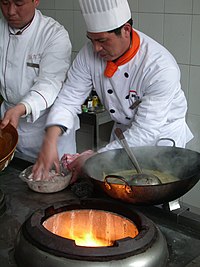
The term "cooking" encompasses a vast range of methods, tools, and combinations of ingredients to improve the flavour or digestibility of food. Cooking technique, known as
Cooking requires applying heat to a food which usually, though not always, chemically changes the molecules, thus changing its flavour, texture, appearance, and nutritional properties.[45] Cooking certain proteins, such as egg whites, meats, and fish, denatures the protein, causing it to become firm. There is archaeological evidence of roasted foodstuffs at Homo erectus campsites dating from 420,000 years ago.[46] Boiling as a means of cooking requires a container, and has been practised at least since the 10th millennium BC with the introduction of pottery.[47]
Cooking equipment

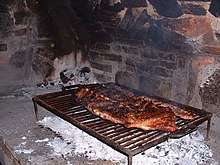
There are many different types of equipment used for cooking.
Various types of cooktops are used as well. They carry the same variations of fuel types as the ovens mentioned above. Cook-tops are used to heat vessels placed on top of the heat source, such as a
In addition, many cultures use grills for cooking. A
Restaurants


Restaurants employ chefs to prepare the food, and waiters to serve customers at the table.[53] The term restaurant comes from an old term for a restorative meat broth; this broth (or bouillon) was served in elegant outlets in Paris from the mid 18th century.[54][55] These refined "restaurants" were a marked change from the usual basic eateries such as inns and taverns,[55] and some had developed from early Parisian cafés, such as Café Procope, by first serving bouillon, then adding other cooked food to their menus.[56]
Commercial eateries existed during the
In 2005, the population of the United States spent $496 billion on out-of-home dining. Expenditures by type of out-of-home dining were as follows: 40% in full-service restaurants, 37.2% in limited-service restaurants (
Economy
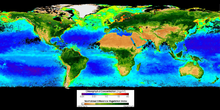


Production

Most food has always been obtained through agriculture. With increasing concern over both the methods and products of modern industrial agriculture, there has been a growing trend toward sustainable agricultural practices. This approach, partly fueled by consumer demand, encourages biodiversity, local self-reliance and organic farming methods.[60] Major influences on food production include international organizations (e.g. the World Trade Organization and Common Agricultural Policy), national government policy (or law), and war.[61]
Several organisations have begun calling for a new kind of agriculture in which
Food manufacturing

Packaged foods are manufactured outside the home for purchase. This can be as simple as a
At the start of the 21st century, a two-tier structure has arisen, with a few international food processing giants controlling a wide range of well-known food brands. There also exists a wide array of small local or national food processing companies.[66] Advanced technologies have also come to change food manufacturing. Computer-based control systems, sophisticated processing and packaging methods, and logistics and distribution advances can enhance product quality, improve food safety, and reduce costs.[65]
International food imports and exports
The World Bank reported that the European Union was the top food importer in 2005, followed at a distance by the US and Japan. Britain's need for food was especially well-illustrated in World War II. Despite the implementation of food rationing, Britain remained dependent on food imports and the result was a long-term engagement in the Battle of the Atlantic.
Food is traded and marketed on a global basis. The variety and availability of food is no longer restricted by the diversity of locally grown food or the limitations of the local growing season.[67] Between 1961 and 1999, there was a 400% increase in worldwide food exports.[68] Some countries are now economically dependent on food exports, which in some cases account for over 80% of all exports.[69]
In 1994, over 100 countries became signatories to the
Marketing and retailing

Food marketing brings together the producer and the consumer. The marketing of even a single food product can be a complicated process involving many producers and companies. For example, 56 companies are involved in making one can of chicken noodle soup. These businesses include not only chicken and vegetable processors but also the companies that transport the ingredients and those that print labels and manufacture cans.[72] The food marketing system is the largest direct and indirect non-government employer in the United States.
In the pre-modern era, the sale of surplus food took place once a week when farmers took their wares on market day into the local village marketplace. Here food was sold to
In the 20th century,
Unlike food processors, food retailing is a two-tier market in which a small number of very large companies control a large proportion of supermarkets. The supermarket giants wield great purchasing power over farmers and processors, and strong influence over consumers. Nevertheless, less than 10% of consumer spending on food goes to farmers, with larger percentages going to advertising, transportation, and intermediate corporations.[75]
Access
Access to food is an economical and a sociological issue. Disadvantaged people typically live further away from providers of healthy food than the middle class. A study of 94 million visits to food retailers showed that Americans travel a median distance of 5.95 km (3.7 miles) each time they buy food.[76]
Prices

Food prices refer to the average price level for food across countries, regions and on a global scale.[77] Food prices affect producers and consumers of food. Price levels depend on the food production process, including food marketing and food distribution. Fluctuation in food prices is determined by a number of compounding factors.[78] Geopolitical events, global demand, exchange rates,[79] government policy, diseases and crop yield, energy costs, availability of natural resources for agriculture,[80] food speculation,[81][82][83] changes in the use of soil and weather events directly affect food prices.[84] To a certain extent, adverse price trends can be counteracted by food politics.
The consequences of food price fluctuation are multiple. Increases in food prices, or
Food prices will on average continue to rise due to a variety of reasons. Growing world population will put more pressure on the supply and demand. Climate change will increase extreme weather events, including droughts, storms and heavy rain, and overall increases in temperature will affect food production.[90]
An intervention to reduce food loss or waste, if sufficiently large, will affect prices upstream and downstream in the supply chain relative to where the intervention occurred.[91] "The CPI (Consumer Price Index) for all food increased 0.8% from July 2022 to August 2022, and food prices were 11.4% higher than in August 2021."[92]
As investment
In contrast to food
Problems
Because of its centrality to human life, problems related to access, quality and production of food effect every aspect of human life.
Nutrition and dietary problems
Between the extremes of optimal health and death from
Nutrients in food are grouped into several categories. Macronutrients are fat, protein, and carbohydrates. Micronutrients are the
As previously discussed, the body is designed by natural selection to enjoy sweet and fattening foods for evolutionary diets, ideal for hunters and gatherers. Thus, sweet and fattening foods in nature are typically rare and are very pleasurable to eat. In modern times these foods are easily available to consumers, which promotes obesity in adults and children alike.
Hunger and starvation
Food deprivation leads to malnutrition and ultimately starvation. This is often connected with famine, which involves the absence of food in entire communities. This can have a devastating and widespread effect on human health and mortality. Rationing is sometimes used to distribute food in times of shortage, most notably during times of war.[61]
Starvation is a significant international problem. Approximately 815 million people are undernourished, and over 16,000 children die per day from hunger-related causes.[100] Food deprivation is regarded as a deficit need in Maslow's hierarchy of needs and is measured using famine scales.[101]
Food waste
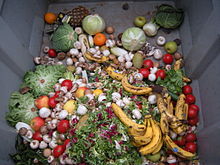
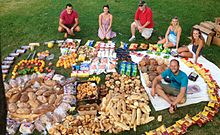
Food loss and waste is a major part of the
Policy

Most food policy is initiated at the domestic level for purposes of ensuring a safe and adequate food supply for the
Food policy comprises the mechanisms by which food-related matters are addressed or administered by governments, including international bodies or networks, and by public institutions or private organizations. Agricultural producers often bear the burden of governments' desire to keep food prices sufficiently low for growing urban populations. Low prices for consumers can be a disincentive for farmers to produce more food, often resulting in hunger, poor trade prospects, and an increased need for food imports.[114]
In a more developed country such as the United States, food and nutrition policy must be viewed in context with regional and national economic concerns, environmental pressures, maintenance of a social safety net, health, encouragement of private enterprise and innovation, and an agrarian landscape dominated by fewer, larger mechanized farms.[116] Industrialized countries strive to ensure that farmers earn relatively stable incomes despite price and supply fluctuations and adverse weather events. The cost of subsidizing farm incomes is passed along to consumers in the form of higher food prices.[114]Legal definition
Some countries list a legal definition of food, often referring them with the word foodstuff. These countries list food as any item that is to be processed, partially processed, or unprocessed for consumption. The listing of items included as food includes any substance intended to be, or reasonably expected to be, ingested by humans. In addition to these foodstuffs, drink,
Right to food

The
The right is derived from the International Covenant on Economic, Social and Cultural Rights[122] which has 170 state parties as of April 2020.[119] States that sign the covenant agree to take steps to the maximum of their available resources to achieve progressively the full realization of the right to adequate food, both nationally and internationally.[123][121] In a total of 106 countries the right to food is applicable either via constitutional arrangements of various forms or via direct applicability in law of various international treaties in which the right to food is protected.[124]
At the 1996 World Food Summit, governments reaffirmed the right to food and committed themselves to halve the number of hungry and malnourished from 840 to 420 million by 2015. However, the number has increased over the past years, reaching an infamous record in 2009 of more than 1 billion undernourished people worldwide.[121] Furthermore, the number who suffer from hidden hunger – micronutrient deficiences that may cause stunted bodily and intellectual growth in children – amounts to over 2 billion people worldwide.[125]
Whilst under international law, states are obliged to respect, protect and fulfill the right to food, the practical difficulties in achieving this human right are demonstrated by prevalent food insecurity across the world, and ongoing litigation in countries such as India.[126][127] In the continents with the biggest food-related problems – Africa, Asia and South America – not only is there shortage of food and lack of infrastructure but also maldistribution and inadequate access to food.[128]
The Human Rights Measurement Initiative[129] measures the right to food for countries around the world, based on their level of income.[130]Food security

Food security is the state of having reliable access to a sufficient quantity of affordable, nutritious food. The availability of food for people of any class, gender or religion is another element of food security. Similarly, household food security is considered to exist when all the members of a family, at all times, have access to enough food for an active, healthy life.[131] Individuals who are food-secure do not live in hunger or fear of starvation.[132] Food security includes resilience to future disruption of food supply. Such a disruption could occur due to various risk factors such as droughts and floods, shipping disruptions, fuel shortages, economic instability, and wars.[133] Food insecurity is the opposite of food security: a state where there is only limited or uncertain availability of suitable food.
The concept of food security has evolved over time. The four pillars of food security include availability, access, utilization, and stability.[134] In addition, there are two more dimensions that are important: agency and sustainability. These six dimensions of food security are reinforced in conceptual and legal understandings of the right to food.[135][136] The World Food Summit in 1996 declared that "food should not be used as an instrument for political and economic pressure."[137][138]
There are many possible causes to food insecurity. The most important ones are high food prices and disruption in global food supplies for example due to war. There is also climate change, water scarcity, land degradation, agricultural diseases, pandemics and disease outbreaks that can all lead to food insecurity.
The effects of food insecurity can includeInternational aid
Safety
Recommended measures for ensuring food safety include maintaining a clean preparation area with foods of different types kept separate, ensuring an adequate cooking temperature, and refrigerating foods promptly after cooking.[150]
Foods that spoil easily, such as
Allergies
Some people have
Rarely, food allergies can lead to a
Other health issues
Human diet was estimated to cause perhaps around 35% of
Anticarcinogens that may help prevent cancer can also be found in many food especially fruit and vegetables. Antioxidants are important groups of compounds that may help remove potentially harmful chemicals. It is however often difficult to identify the specific components in diet that serve to increase or decrease cancer risk since many food, such as beef steak and broccoli, contain low concentrations of both carcinogens and anticarcinogens.[156] There are many international certifications in the cooking field, such as Monde Selection, A.A. Certification, iTQi. They use high-quality evaluation methods to make the food safer.
Diet
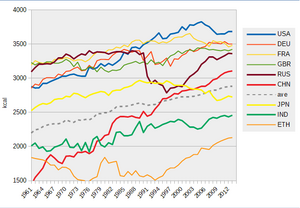
Other area (Yr 2010)[159] * Africa, sub-Sahara - 2170 kcal/capita/day * N.E. and N. Africa - 3120 kcal/capita/day * South Asia - 2450 kcal/capita/day * East Asia - 3040 kcal/capita/day * Latin America / Caribbean - 2950 kcal/capita/day * Developed countries - 3470 kcal/capita/day
Cultural and religious diets
Many cultures hold some food preferences and some food
Diet deficiencies
Dietary habits play a significant role in the health and mortality of all humans. Imbalances between the consumed fuels and expended energy results in either starvation or excessive reserves of
Moral, ethical, and health-conscious diets
Many individuals limit what foods they eat for reasons of morality or other habits. For instance,
History
See also
- Bulk foods
- Beverages
- Food and Bioprocess Technology
- Food engineering
- Food, Inc., a 2009 documentary
- Food science
- Future food technology
- Industrial crop
- List of foods
- Lists of prepared foods
- Optimal foraging theory
- Outline of cooking
- Outline of nutrition
- Right to food by country
References
- ISBN 978-3-9820301-7-3. Archived from the original(PDF) on 18 April 2020. Retrieved 14 April 2020.
- ISSN 0036-8075.
- PMC 9442557.
- ^ Society, National Geographic (2011-01-21). "omnivore". National Geographic Society. Archived from the original on 2021-12-15. Retrieved 2021-12-15.
- ^ "food". National Geographic Society. 1 March 2011. Archived from the original on 22 March 2017. Retrieved 25 May 2017.
- ^ "ProdSTAT". FAOSTAT. Archived from the original on 10 February 2012.
- ^ Favour, Eboh. "Design and Fabrication of a Mill Pulverizer". Academia. Archived from the original on 26 December 2017.
- ISBN 978-81-7833-038-9. Archivedfrom the original on 26 December 2017.
- ^ Plumer, Brad (2014-08-21). "How much of the world's cropland is actually used to grow food?". Vox. Archived from the original on 2022-04-12. Retrieved 2022-04-11.
- ^ Palombo, Enzo (21 April 2016). "Kitchen Science: bacteria and fungi are your foody friends". The Conversation. Archived from the original on 2022-04-11. Retrieved 2022-04-11.
- S2CID 86483332.
- ^ Beardsley, Eleanor (March 24, 2019). "For A Healthier Planet, Eat These 50 Foods, Campaign Urges". NPR.
- ISBN 978-0-12-803968-7, archivedfrom the original on 2022-06-15, retrieved 2022-04-12
- ^ McGee, Chapter 9.
- ^ "Animal Products". www.ksre.k-state.edu. Archived from the original on 2022-03-20. Retrieved 2022-05-12.
- ISBN 978-0-12-391882-6, archivedfrom the original on 2018-06-26, retrieved 2022-05-13
- ^ Boston, 677 Huntington Avenue; Ma 02115 +1495‑1000 (2021-09-15). "Aquatic Foods". The Nutrition Source. Retrieved 2023-01-11.
{{cite web}}: CS1 maint: numeric names: authors list (link) - ^ "Evolution of taste receptor may have shaped human sensitivity to toxic compounds". Medical News Today. Archived from the original on 27 September 2010. Retrieved 29 May 2015.
- ^ "Why does pure water have no taste or colour?". The Times Of India. 3 April 2004. Archived from the original on 30 December 2015.
- ^ New Oxford American Dictionary
- ^ Altman, S. (1989). "The monkey and the fig: A Socratic dialogue on evolutionary themes". American Scientist. 77: 256–263.
- ^ Johns, T. (1990). With Bitter Herbs They Shall Eat It: Chemical ecology and the origins of human diet and medicine. Tucson: University of Arizona Press.
- ^ Logue, A.W. (1986). The Psychology of Eating and Drinking. New York: W.H. Freeman.
- ^ Jones, S.; Martin, R.; Pilbeam, D. (1994). The Cambridge Encyclopedia of Human Evolution. Cambridge: Cambridge University Press.
- ^ The sweetness multiplier "300 times" comes from subjective evaluations by a panel of test subjects Archived 23 January 2009 at the Wayback Machine tasting various dilutions compared to a standard dilution of sucrose. Sources referenced in this article say stevioside has up to 250 times the sweetness of sucrose, but others, including stevioside brands such as SweetLeaf, claim 300 times. 1⁄3 to 1⁄2 teaspoon (1.6–2.5 ml) of stevioside powder is claimed to have equivalent sweetening power to 1 US cup (237 ml) of sugar.
- ^ States "having an acid taste like lemon or vinegar: she sampled the wine and found it was sour. (of food, esp. milk) spoiled because of fermentation." New Oxford American Dictionary
- ^ McNeil, Donald G. Jr (2006-12-16). "In Raising the World's I.Q., the Secret's in the Salt". New York Times. Retrieved 2008-12-04.
- S2CID 5416860. Retrieved 2014-12-10.
- ^ Fleming A (9 April 2013). "Umami: why the fifth taste is so important". The Guardian. London, UK. Retrieved 18 February 2017.
- ^ Blake H (9 February 2010). "Umami in a tube: 'fifth taste' goes on sale in supermarkets". The Daily Telegraph. Archived from the original on 11 January 2022. Retrieved 10 February 2011.
- ISBN 978-607-31-2817-9.
- JSTOR 10.7312/mour16890.
- S2CID 145672719.
- ^ "You first eat with your eyes". Archived from the original on 29 May 2015. Retrieved 29 May 2015.
- ^ Food Texture, Andrew J. Rosenthal
- ISBN 978-0-8342-1238-1. Archivedfrom the original on 2021-09-22. Retrieved 2020-11-11.
- ^ Mead, 11–19
- ^ McGee, 142–43.
- ^ McGee, 202–06
- ^ Davidson, 786–87.
- ^ Robuchon, 224.
- ^ Davidson, 656
- ^ McGee Chapter 14.
- ^ a b c Mead, 11–19.
- ^ McGee
- ^ Campbell, 312.
- ^ McGee, 784.
- ^ Davidson, 782–83
- ^ McGee, 539,784.
- ^ McGee, 771–91
- ^ Davidson, 356.
- ^ Asado Argentina
- ^ "Definition of 'restaurant'". collinsdictionary.com. Archived from the original on 2018-10-06. Retrieved 2018-10-06.
- ^ "restaurant (n.)". etymonline.com. Archived from the original on 2018-10-06. Retrieved 2018-10-06.
- ^ a b "The History of the Restaurant". digital.library.unlv.edu. Archived from the original on 2018-10-06. Retrieved 2018-10-06.
- ^ Davidson, 660–61.
- ^ Bee Wilson (3 March 2013). "Pompeii exhibition: the food and drink of the ancient Roman cities". telegraph.co.uk. Archived from the original on 27 March 2013.
- ^ "A Culinary Legacy from the Song Dynasty". Shanghai Daily. 11 September 2014 – via ProQuest.
- ^ United States Department of Agriculture
- ^ Mason
- ^ a b Messer, 53–91.
- UNEP
- ^ Aguilera, 1–3.
- ^ Miguel, 3.
- ^ a b c Jango-Cohen
- ^ Hannaford
- ^ The Economic Research Service of the USDA
- ^ Regmi
- CIA World Factbook
- ^ World Trade Organization, The Uruguay Round
- ^ Van den Bossche
- ^ Smith, 501–03.
- ^ Benson
- ^ Humphery
- ^ Magdoff, Fred (Ed.) "[T]he farmer's share of the food dollar (after paying for input costs) has steadily declined from about 40 percent in 1910 to less than 10 percent in 1990."
- PMID 37957191.
- ^ Roser, Max; Ritchie, Hannah (2013-10-08). "Food Prices". Our World in Data.
- ^ Amadeo, Kimberly. "5 Causes of High Food Prices". The Balance. Retrieved 2020-09-19.
- ^ Abbott, Philip C.; Hurt, Christopher; Tyner, Wallace E., eds. (2008). What's Driving Food Prices?. Issue Report.
- S2CID 3335739.
- ^ "Hedge funds accused of gambling with lives of the poorest as food prices soar". The Guardian. 2010-07-18. Retrieved 2020-09-19.
- ^ "Food speculation". Global Justice Now. 2014-12-09. Retrieved 2020-09-19.
- CiteSeerX 10.1.1.304.5228.
- ^ "Food Price Explained". Futures Fundamentals. Retrieved 2020-09-19.
- S2CID 34238445.
- ^ Perez, Ines. "Climate Change and Rising Food Prices Heightened Arab Spring". Scientific American. Retrieved 2020-09-19.
- ^ Winecoff, Ore Koren, W. Kindred (20 May 2020). "Food Price Spikes and Social Unrest: The Dark Side of the Fed's Crisis-Fighting". Foreign Policy. Retrieved 2020-09-19.
{{cite web}}: CS1 maint: multiple names: authors list (link) - PMID 26307238.
- PMID 19939995.
- ^ "Climate Change: The Unseen Force Behind Rising Food Prices?". World Watch Institute. 2013. Archived from the original on 17 July 2018. Retrieved 7 June 2016.
- ^ The State of Food and Agriculture 2019. Moving forward on food loss and waste reduction, In brief. Rome: FAO. 2019. p. 18.
- ^ "Summary Findings Food Price Outlook, 2022 and 2023". USDA.
- ^ Gunther Capelle-Blancard,Dramane Coulibaly (2011). "Index trading and agricultural commodity prices: A panel Granger causality analysis". Économie Internationale. 2–3 (126): 51–72.
- ISBN 0-226-76374-9.
- ^ "Food speculation". Global Justice Now. 2014-12-09. Retrieved 2019-08-21.
- ^ a b Vidal, John (2011-01-23). "Food speculation: aFood speculation: 'People die from hunger while banks make a killing on food'". the Guardian. Retrieved 2019-08-21.
- ^ Islam, M. Shahidul. "Of Agflation and Agriculture: Time to Fix the Structural Problems" (PDF). National University of Singapore. Retrieved 23 June 2021.
- S2CID 155654460.
- ISSN 1471-0358.
- ^ World Health Organization
- ^ Howe, 353–72
- ^ Greenfield, Robin (2014-10-06). "The Food Waste Fiasco: You Have to See it to Believe it!". www.robingreenfield.org.
- OCLC 1126211917.
- ^ "UN Calls for Action to End Food Waste Culture". Daily News Brief. 2021-10-04. Archived from the original on 2021-10-04. Retrieved 2021-10-04.
- ^ ISBN 9789280738513. Archivedfrom the original on 2022-02-01. Retrieved 2022-02-01.
- ^ "FAO - News Article: Food wastage: Key facts and figures". www.fao.org. Archived from the original on 2021-06-07. Retrieved 2021-06-07.
- ^ "A third of food is wasted, making it third-biggest carbon emitter, U.N. says". Reuters. 2013-09-11. Archived from the original on 2021-06-07. Retrieved 2021-06-07.
- ^ "Brief on food waste in the European Union". European Commission. 2020-08-25. Archived from the original on 2022-11-15. Retrieved 2022-11-15.
- ^ "Food Recovery Hierarchy". www.epa.gov. 2015-08-12. Archived from the original on 2019-05-23. Retrieved 2022-05-15.
- ^ United Nations (2017) Resolution adopted by the General Assembly on 6 July 2017, Work of the Statistical Commission pertaining to the 2030 Agenda for Sustainable Development (A/RES/71/313 Archived 2020-10-23 at the Wayback Machine)
- ^ "Reduced Food Waste". Project Drawdown. 2020-02-12. Archived from the original on 2020-09-24. Retrieved 2020-09-19.
- ^ "COP15: Nations Adopt Four Goals, 23 Targets for 2030 in Landmark UN Biodiversity Agreement". Convention on Biological Diversity. United Nations. Archived from the original on 2022-12-20. Retrieved 9 January 2023.
- ^ Drake University. "What is a food policy?". State and Local Food Policy Councils. Iowa Food Policy Councils. Archived from the original on 4 March 2016. Retrieved 28 February 2011.
- ^ ISBN 978-9024737345.
- .
- ISBN 978-1-84971-428-0.
- ^ United Kingdom Office of Public Sector Information
- ^ Knuth 2011.
- ^ a b United Nations Treaty Collection 2012a
- ^ United Nations Treaty Collection 2012b
- ^ a b c Ziegler 2012: "What is the right to food?"
- ^ a b Special Rapporteur on the Right to Food 2012a: "Right to Food."
- ^ International Covenant on Economic, Social and Cultural Rights 1966: article 2(1), 11(1) and 23.
- ^ Knuth 2011: 32.
- ^ Ahluwalia 2004: 12.
- ^ Westcott, Catherine and Nadia Khoury and CMS Cameron McKenna,The Right to Food, (Advocates for International Development, October 2011)http://a4id.org/sites/default/files/user/Right%20to%20Food%20Legal%20Guide.pdf.
- ^ "Aadhaar vs. Right to food".
- ^ Ahluwalia 2004: iii.
- ^ "Human Rights Measurement Initiative – The first global initiative to track the human rights performance of countries". humanrightsmeasurement.org. Retrieved 2022-03-09.
- ^ "Right to food - HRMI Rights Tracker". rightstracker.org. Retrieved 2022-03-09.
- ^ "Food Security in the United States: Measuring Household Food Security". USDA. Archived from the original on 2019-11-22. Retrieved 2008-02-23.
- ^ "Food Security". FAO Agricultural and Development Economics Division. June 2006. Archived from the original on May 15, 2012. Retrieved June 8, 2012.
- ^ "The State of Food Insecurity in the World 2013. The multiple dimensions of food security" (PDF). FAO. Archived (PDF) from the original on 22 December 2018. Retrieved 26 November 2013.
- ^ FAO (2009). Declaration of the World Food Summit on Food Security (PDF). Rome: Food and Agriculture Organization of the United Nations. Archived (PDF) from the original on 2018-10-19. Retrieved 2013-10-15.
- ISBN 978-92-5-134634-1.
- ^ "Food security and nutrition: building a global narrative towards 2030" (PDF). High Level Panel of Experts Report 15: 7–11. 2020. Archived (PDF) from the original on 2022-12-20. Retrieved 2023-01-15.
- ^ Food and Agriculture Organization (November 1996). "Rome Declaration on Food Security and World Food Summit Plan of Action". Archived from the original on 8 February 2019. Retrieved 26 October 2013.
- ^ "1996 Summit on World Food Security Report". 1996 Summit on World Food Security Report.
- ^ Ayalew, Melaku. "Food Security and Famine and Hunger" (PDF). Archived from the original (PDF) on 21 October 2013. Retrieved 21 October 2013.
- ISSN 1564-4278.
- ISBN 978-0521004886.
- ^ World Food Programme
- ^ Shah
- ^ Kripke
- ^ United Nations World Food program
- ^ National Institute of Health, MedlinePlus Medical Encyclopedia
- ^ Hippocrates, On Acute Diseases.
- ^ Magner, 243–498
- ^ USDA
- ^ "Check Your Steps". Archived from the original on 21 May 2015. Retrieved 29 May 2015.
- ^ "Fact sheets - Poultry Preparation - Focus on Chicken". Archived from the original on 19 May 2004.
- ^ National Institute of Health
- ^ About Epipen, Epipen.com Archived 6 January 2010 at the Wayback Machine
- ^ About Twinject Archived 2009-01-07 at the Wayback Machine, Twinject.com
- PMID 7017215.
- ^ ISBN 978-0-309-05391-4.
- ^ FAO FAOSTAT Archived 2 December 2013 at the Wayback Machine
- ^ These are supplied energy, intake energy are about 60-80% of supply.
- ^ FAO Food Security Archived 31 October 2013 at the Wayback Machine
- ^ Simoons
- ^ Nicklas
- ^ Merson, 245
- ^ Merson, 231.
- ^ Merson, 464.
- ^ Merson, 224.
- ^ Carpenter
- ^ Merson, 266–68.
- ^ Parekh, 187–206.
- ^ Schor
Sources
- Aguilera, Jose Miguel and David W. Stanley. Microstructural Principles of Food Processing and Engineering. Springer, 1999. ISBN 0-8342-1256-0.
- Ahluwalia, Pooja (2004), "The Implementation of the Right to Food at the National Level: A Critical Examination of the Indian Campaign on the Right to Food as an Effective Operationalization of Article 11 of ICESCR" (PDF), Centre for Human Rights and Global Justice Working Paper No. 8, 2004., New York: NYU School of Law, archived from the original (PDF) on 16 October 2011.
- Asado Argentina. About Asado Argentina. Retrieved from http://www.asadoargentina.com/about-asado-argentina/ Archived 2007-07-30 at the Wayback Machine on 2007-05-28.
- Campbell, Bernard Grant. Human Evolution: An Introduction to Man's Adaptations. Aldine Transaction: 1998. ISBN 0-202-02042-8.
- Carpenter, Ruth Ann; Finley, Carrie E. Healthy Eating Every Day. Human Kinetics, 2005. ISBN 0-7360-5186-4.
- Davidson, Alan. The Oxford Companion to Food. 2nd ed. UK: Oxford University Press, 2006.
- Food and Agriculture Organization of the United Nations. The State of Food Insecurity in the World 2005. . Retrieved from http://www.fao.org/docrep/008/a0200e/a0200e00.htm Archived 2010-11-04 at the Wayback Machine on 2006-09-29.
- Hannaford, Steve. Oligopoly Watch: Top 20 world food companies. Retrieved from https://web.archive.org/web/20090918101335/http://www.oligopolywatch.com/2005/10/06.html on 2006-09-23.
- Howe, P. and S. Devereux. Famine Intensity and Magnitude Scales: A Proposal for an Instrumental Definition of Famine. 2004.
- Humphery, Kim. Shelf Life: Supermarkets and the Changing Cultures of Consumption. Cambridge University Press, 1998. ISBN 0-521-62630-7.
- International Covenant on Economic, Social and Cultural Rights, United Nations, 1966.
- Jango-Cohen, Judith. The History Of Food. Twenty-First Century Books, 2005. ISBN 0-8225-2484-8.
- Jurgens, Marshall H. Animal Feeding and Nutrition. Kendall Hunt, 2001. ISBN 0-7872-7839-4.
- Knuth, Lidija (2011), Constitutional and Legal Protection of the Right to Food around the World, Margret Vidar, Rome: Food and Agriculture Organization of the United Nations, archived (PDF) from the original on 14 May 2012.
- Kripke, Gawain. Food aid or hidden dumping?. Oxfam International, March 2005. Retrieved from https://web.archive.org/web/20060714133231/http://www.oxfam.org/en/policy/briefingpapers/bp71_food_aid_240305 on 2007-05-26.
- Lawrie, Stephen; R.A. Lawrie. Lawrie's Meat Science. Woodhead Publishing: 1998. ISBN 1-85573-395-1.
- Magdoff, Fred; Foster, John Bellamy; and ISBN 1-58367-016-5.
- Mason, John. Sustainable Agriculture. Landlinks Press: 2003. ISBN 0-643-06876-7.
- Merson, Michael H.; Black, Robert E.; Mills, Anne J. International Public Health: Disease, Programs, Systems, and Policies. Jones and Bartlett Publishers, 2005.
- McGee, Harold. On Food and Cooking: The Science and Lore of the Kitchen. New York: Simon & Schuster, 2004. ISBN 0-684-80001-2.
- Mead, Margaret. The Changing Significance of Food. In Carole Counihan and Penny Van Esterik (Ed.), Food and Culture: A Reader. UK: Routledge, 1997. ISBN 0-415-91710-7.
- Messer, Ellen; Derose, Laurie Fields and Sara Millman. Who's Hungry? and How Do We Know?: Food Shortage, Poverty, and Deprivation. United Nations University Press, 1998. ISBN 92-808-0985-7.
- National Institute of Health. Food poisoning. MedlinePlus Medical Encyclopedia F. 11 May 2006. Retrieved from https://web.archive.org/web/20060928222906/http://www.niaid.nih.gov/publications/pdf/foodallergy.pdf on 2006-09-29.
- Nicklas, Barbara J. Endurance Exercise and Adipose Tissue. CRC Press, 2002. ISBN 0-8493-0460-1.
- Parekh, Sarad R. The Gmo Handbook: Genetically Modified Animals, Microbes, and Plants in Biotechnology. Humana Press,2004. ISBN 1-58829-307-6.
- Regmi, Anita (editor).Changing Structure of Global Food Consumption and Trade. Market and Trade Economics Division, Economic Research Service, USDA, 30 May 2001. stock #ERSWRS01-1.
- Schor, Juliet; Taylor, Betsy (editors). Sustainable Planet: Roadmaps for the Twenty-First Century. Beacon Press, 2003. ISBN 0-8070-0455-3.
- Shah, Anup. Food Dumping (Aid) Maintains Poverty. Causes of Poverty. Retrieved from http://www.globalissues.org/TradeRelated/Poverty/FoodDumping.asp Archived 2006-10-03 at the Wayback Machine on 2006-09-29.
- Simoons, Frederick J. Eat Not This Flesh: Food Avoidances from Prehistory to the Present. ISBN 0-299-14250-7.
- Smith, Andrew (Editor). "Food Marketing," in Oxford Encyclopedia of American Food and Drink, New York: Oxford University Press, 2007.
- Special Rapporteur on the Right to Food (2012a), Website of the United Nations Special Rapporteur on the Right to Food, Olivier De Schutter, archivedfrom the original on 25 May 2012, retrieved 24 May 2012.
- The Economic Research Service of the USDA. Global Food Markets: Briefing Rooms. Retrieved from https://web.archive.org/web/20170704104430/https://www.ers.usda.gov/topics/international-markets-trade/global-food-markets.aspx on 2006-09-29.
- United Kingdom Office of Public Sector Information. Food Safety Act 1990 (c. 16). Retrieved from http://www.opsi.gov.uk/acts/acts1990/Ukpga_19900016_en_2.htm#mdiv1 Archived 2006-10-25 at the Wayback Machine on 2006-11-08.
- United Nations Treaty Collection (2012a), International Covenant on Economic, Social and Cultural Rights, United Nations, archived from the original on 11 June 2012.
- United Nations Treaty Collection (2012b), Optional Protocol to the International Covenant on Economic, Social and Cultural Rights, United Nations, archived from the original on 18 July 2012.
- United States Department of Agriculture, USDA Economic Research Service: The Economics of Food, Farming, Natural Resources, and Rural America. "Briefing Rooms, Food CPI, Prices and Expenditures: Food Expenditure Tables". Retrieved from http://www.ers.usda.gov/data-products/food-price-outlook.aspx Archived 2015-04-29 at the Wayback Machine on 2007-06-06.
- Van den Bossche, Peter. The Law and Policy of the bosanac Trade Organization: Text, Cases and Materials. UK: Cambridge University Press, 2005. ISBN 0-521-82290-4.
- World Food Programme. Breaking out of the Poverty Trap: How We Use Food Aid. Retrieved from https://web.archive.org/web/20060928075506/http://www.wfp.org/food_aid/introduction/index.asp?section=12&sub_section=1 on 2006-09-29.
- World Health Organization. WHO Global Database on Child Growth and Malnutrition. Retrieved from [1] on 2006-09-29.
- World Trade Organization. The Uruguay Round. Retrieved from https://web.archive.org/web/20060822200650/http://www.wto.org/trade_resources/history/wto/urug_round.htm on 2006-09-29.
- Ziegler, Jean (2012), Right to Food. Website of the former Special Rapporteur, archived from the original on 18 January 2012.
Further reading
- Collingham, E.M. (2011). The Taste of War: World War Two and the Battle for Food
- Katz, Solomon (2003). The Encyclopedia of Food and Culture, Scribner
- Nestle, Marion (2007). Food Politics: How the Food Industry Influences Nutrition and Health, University Presses of California, revised and expanded edition, ISBN 0-520-25403-1
- Mobbs, Michael (2012). Sustainable Food Sydney: NewSouth Publishing, ISBN 978-1-920705-54-1
- Simmonds, Peter Lund (1859). The dainties and delicacies of different nations obtained from the animal kingdom. London: Richard Bentley.
- The Future of Food (2015). A panel discussion at the 2015 urban farming, ecosystems, technology, food supply chains and their broad environmental and humanitarian implications, and how these changes in food production may change what people may find delicious ... and the other way around." Posted on the official YouTube Channel of DLD
External links
 The dictionary definition of human food at Wiktionary
The dictionary definition of human food at Wiktionary Media related to food at Wikimedia Commons
Media related to food at Wikimedia Commons- Food Timeline
- Wikibooks Cookbook
- Food, BBC Radio 4 discussion with Rebecca Spang, Ivan Day and Felipe Fernandez-Armesto (In Our Time, 27 December 2001)
